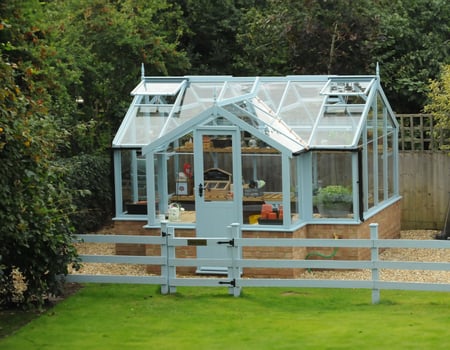12 Helpful Pointers for Buying Greenhouses
Written by Matt W (Greenhousestores) on 19th Oct 2016.

A guide to picking and setting up your greenhouse.
Find your greenhouse
Greenhouses come in many different shapes, sizes and styles, making it easy to find one that suits your tastes and wallet best. There are all sorts of designs from classic to contemporary styles. The best rule of thumb for buying a greenhouse is definitely with what you can afford; buy the best and biggest that you can. As always, quality shouldn’t be overlooked.
Against the wall or free standing?
There are two types of greenhouse; a lean-to or walk in. A lean-to greenhouse would share one of its walls with an already existing brick wall or the side of a building and have a sloping roof away from the wall. Typical walk in greenhouse would have four sides like a little house with a door or two doors at either end.
Flexible seasons
Having a greenhouse means that you have the convenience and power to be more flexible with the seasons. A greenhouse can stretch the season for you so that you are about to grow different seasonal fruits and vegetables for longer. Summer fruits and veg such as strawberries or aubergines can be grown in autumn and winter oriental greens can be grown in spring.
Not only would you be able to stretch the seasons, you would be able to protect your plants from different and difficult weather conditions. Strong winds, heavy rains, or any turbulent growing conditions will not be a worry for plants inside a greenhouse.
Optimum greenhouse spots
It is essential to find a good location for you greenhouse. Obviously, location can be limited with lean-to greenhouses, but try to find somewhere where all four sides can get a good stream of sunlight. If you can avoid walls, buildings or hedges that would be ideal. Placing the greenhouse under a tree is also not a great idea. If your greenhouse is long and narrow, then an east-west orientation is the best.
Framing
If you have to contend with a lot of rain, we would recommend choosing an aluminium frame. It doesn’t require any maintenance and will not rot or rust. You can also get it painted in all sorts of colours. Wester red cedar frames are a favourite as well. They look great and smell nice. They do have a long life span but will give way to rotting in the end.
Glass
Typical glazing for greenhouses is either glass or polycarbonate. It is worth taking into consideration what will be going on around your greenhouse. If there are children and balls being played nearby then although the glass might break, the tough polycarbonate glazing won’t. This type of safety glass shatters like a car windscreen instead and could be a much safer option for your garden.
A strong base
It is vital that the greenhouse stands on a strong solid base. Good suppliers will give advice on precise dimensions. There are brick, timber, concrete or combination made bases. You can have a look at recycled plastic lumber as well. This lumber requires no maintenance and never rots, and you can also get it in a variety of colours.
How to grow
Your greenhouse can be built on soil that you can actually grow into or you can lay metal staging or tiered timber and use pots or growbags instead. You could even build a raised bed to garden on. If you are growing in the soil itself then you should work form a central path. How you organize your greenhouse is really up to you. You could even try having all 3 options in the one greenhouse.
Go green on your heating
We really recommend getting most your heating for your greenhouse from the most environmentally friendly and free option: sunshine. Greenhouses aren’t the best at retaining artificial heating, so paid heating can become very costly, not to mention the carbon footprint that would produce. If you feel it essential, then we would suggest a 100% renewable supplier for electric heating, as it also creates a better growing environment.
Watering your greenhouse
You can collect a surprising amount of rainwater from the roof of your greenhouse so that is definitely worth noting and storing. Of course, the greenhouse will need a religious amount of watering, but if you are away a lot and would like a mains supply in your greenhouse then you will need to get some plumbing work done.
Vent that greenhouse
As we all know hot air rises, so the hot air will have to get out somehow, this is where vents come in. It is very important to put vents in your greenhouse, especially in summer so that you can get cool air circulating. For the best growing conditions you need a constant flow of hot air leaving and cool air coming into your greenhouse. Don’t be stingy with louvres and make sure you check with your manufacturer for the best number of roof vents you can fit in. If you are out all day, it’s worth investing in automatic openers on your vents.
Repairs and spares
If you need any other parts or gadgets for your greenhouse just do a quick google search. There is a lot out there. You can also take a photo of details that are useful and send it to suppliers to find the exact thing you are looking for.